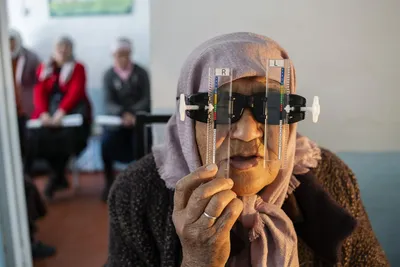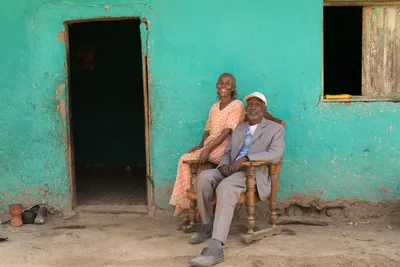While the topic is highly complex, nuclear weapons have been consistently depicted in similar ways worldwide: as symbols of power wielded by powerful figures, often portrayed with fully assembled bombs pointed upwards. Certain nations are depicted as responsible actors while others are not, reinforcing stereotypes. Our analysis aims to explore these common visual tropes, highlighting their impact and proposing more inclusive representations. We were tasked with examining these stereotypes and their implications, aiming to enhance ethical communication and journalism for truthful and representative reporting.
The commission came from Lex International, which advocates for nuclear disarmament among other causes, and was substantially supported by ICAN, the International Campaign to Stigmatise, Prohibit & Eliminate Nuclear Weapons, which won the Nobel Peace Prize in 2017.

When we Google "nuclear warfare," we see a very uniform picture full of clichés. It shows many facets of what the dominant narrative entails.
Excerpt from the pitch deck for journalists developed by Fairpicture. The link to the full document can be found below.
Our approach involves analyzing prevailing stereotypes and their societal effects, aiming to promote truthful and inclusive representation through ethical journalism practices. We believe this method can be useful in many applications. The power of images is immense, and challenging the pictures in people's minds can foster necessary change and enable more diverse discourses.
We examine widely circulated images across media, archives, and communications from various organizations. We question: who is portrayed in what roles and how frequently? What remains unseen, whose voices are not heard? This is often intertwined with power dynamics—prevailing images often serve specific interests. In the following article, you will discover how this manifests in the context of nuclear weapons.
Challenging Dominant Narratives Through Visual Representation
In the realm of nuclear weapons discourse, what we see often shapes our understanding and beliefs. Images of atomic bombs, mushroom clouds, and military installations dominate our media and collective consciousness. These visuals perpetuate specific narratives:
These images are predominantly militarized, reflecting their origins and control within military contexts.
However, what remains unseen is equally significant:
The absence of ordinary people in imagery related to nuclear topics is striking. Individuals impacted by nuclear policies, activists advocating for disarmament, and workers within the nuclear industry are conspicuously absent from the narrative.

There are hardly any people depicted in imagery related to nuclear warfare, atomic bombs, nuclear energy, or nuclear waste disposal. Yet, people are not only involved in all these fields at every step of the process but also directly and indirectly impacted by these activities.
Excerpt from the pitch deck for journalists developed by Fairpicture. The link to the full document can be found below.
The persistent lack of human presence in nuclear imagery raises critical questions about its intended audience and purpose. Why do representations of the arms industry and nuclear issues exclude ordinary people? This deliberate framing through images fosters:
This dominant narrative influences public perception profoundly. By omitting personal stories and fostering detached representations, it perpetuates racial, gender, and postcolonial biases.
Magnus Løvold, Lex International
Independent journalists play a crucial role in challenging and diversifying the visual representation of nuclear issues. By presenting a spectrum of voices and perspectives—from policymakers and scientists to affected communities and activists—they uphold journalistic integrity and facilitate informed public discourse.
Empowering Picture Editors
Picture editors wield significant influence over public perception. By consciously selecting and framing images that:
Using alternative imagery has transformative potential. By diversifying narratives and humanizing nuclear issues, we can inspire action and promote a more nuanced understanding among audiences. Similar shifts in public perception have catalyzed action on pressing global issues like climate change, emphasizing the human dimensions and injustices at stake.
Challenging dominant stereotypes through visual representation is a matter of journalistic integrity and ethical responsibility. By amplifying unheard voices and shedding light on overlooked aspects of the nuclear discourse, we contribute to a more inclusive and constructive dialogue. It's time to broaden the lens, amplify diverse perspectives, and visualize a future where nuclear weapons are no longer central to global security.
This example illustrates the power of questioning prevailing stereotypes across various fields. If you're interested in delving deeper, here are links to the papers we've prepared.
You can find the detailed, practice-oriented full report here.

July 2025 - Laura Abad Guerrero
Last week, that now-infamous Coldplay concert clip, where a “Kiss Cam” moment spiraled into global speculation. This follow-up is about asking whether the laws and practices we’ve normalized still make sense in a world where tech moves faster than consent.
Learn more about Consent by Ticket? Rethinking Visual Privacy in the Age of Virality

November 2023 - N'Deane Helajzen
Discover how AI reshapes creative storytelling and faces ethical hurdles in our latest post.
Learn more about Navigating Generative AI in Ethical Visual Communication: Opportunities, Challenges, and the Role of Authenticity

February 2023 - Jörg Arnold
Development work is under fire. Voices from the Global South are now increasingly being heard in the Global North. But: Which images do we show?
Learn more about More than just a question of perspective. Why development needs different images